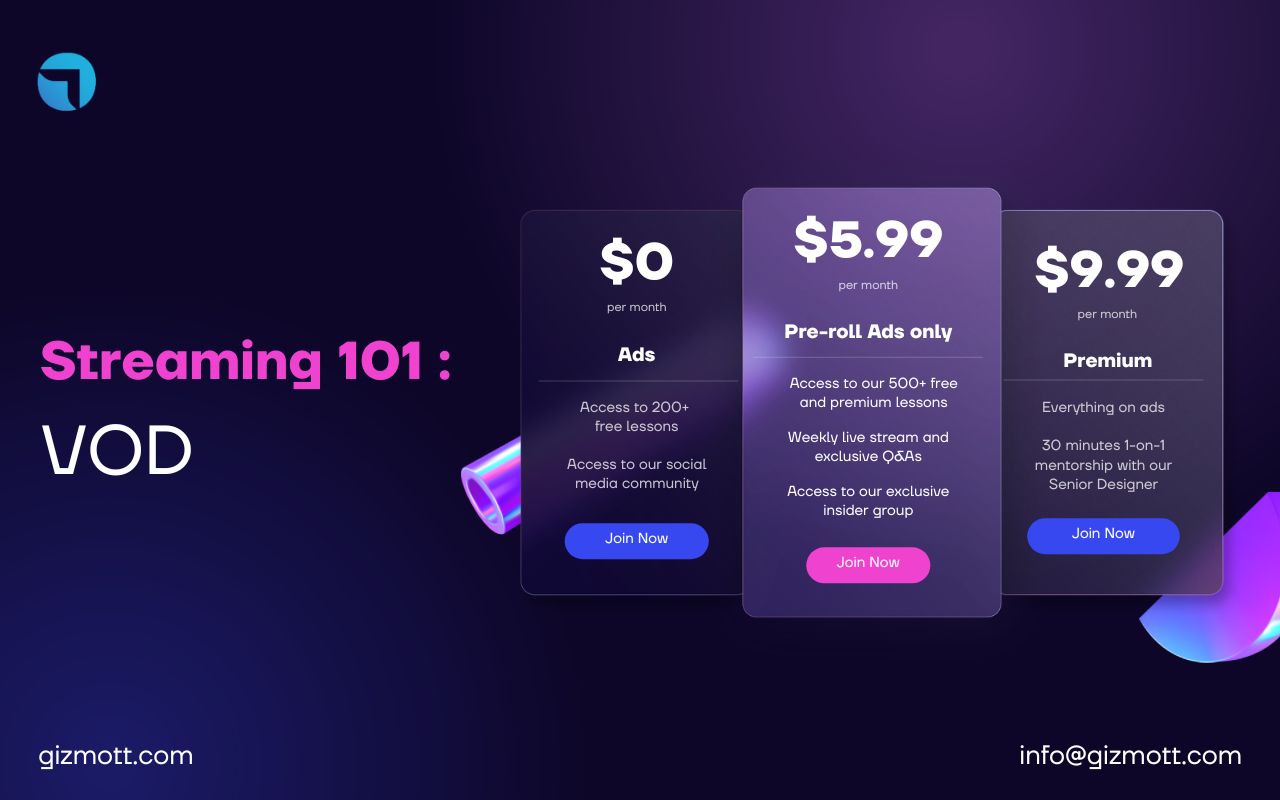The introduction of the internet has significantly changed how we engage with video. Innovative internet services like YouTube, Vimeo, and Twitch, as well as Netflix, Hulu, and Amazon Video, among others, now have access to content delivery across wired and wireless telecoms networks.
But technology has also altered the way we watch content; gone are the days when we had to pick a show from a small number of TV networks and wait a week for the next episode. With the capacity to download internet video nearly immediately after the action has taken place, we no longer need to wait for our sporting highlights.
Today, we can stream shows “live” or download them for later, time-shifted viewing, so that we can watch them whenever we want. Video on demand is the umbrella word for this new genre of entertainment. Now, instead of when a broadcaster or content owner decides to deliver it, we receive our stuff when we want.
What is VOD?
Video-on-demand, or VoD, is a way of watching movies that users select from a library at anytime, anywhere, and on any device, depending on their preferences. VoD emphasizes the idea of watching videos according on the user’s needs as opposed to watching linear TV’s pre-scheduled programmes.
The exciting thing about video on demand is that users can watch their videos whenever and wherever they want because they are not constrained by broadcasting schedules. As online video platform providers allow users the freedom and flexibility to access video content including TV series, movies, and more, VOD solutions are growing in popularity among viewers and companies.
Choosing a Video-On-Demand platform that covers all your needs might be a task, but in this guide, we’ve simplified it for you. Gizmott lets you access content from anywhere on any device, giving your customers a feature-rich platform offering both VOD and Live Streaming solutions.
To explore more options in regard with the Video-On-Demand services we provide, contact us through https://gizmott.com/gizmott-contact-us/ or drop us a line at info@gizmott.com.
How does Video On Demand work?
The film or television programme is converted to a digital format and stored in a video server before being sent to your home. The movie is originally compressed & delivered over the cable or broadband connection when a VOD request is made. When a movie stream reaches the server, it is decoded and decompressed using a setup box before being saved on a video server on the viewer’s computer or television.
Ultimately, a large resource of TV shows, movies, and documentaries is pooled into one location for anyone to access. The access is usually tied to a condition, like making payments through subscriptions or watching ads.
What are the benefits of a VOD platform?
Online video is being embraced by the people like never before, with the number of viewers of video-on-demand expected to reach 164.9 million by 2025. This implies that video is also becoming a crucial component of every industry, particularly for content creators and distributors.
And there are a number of important factors that have contributed to the necessity of VOD; let’s delve into these.
• Increased Viewership
One of the primary advantages of VOD streaming is that it can enhance viewership for your content. More chances for monetization, such as through advertising or paid subscriptions, may arise as a result of increased viewership. Additionally, more viewers might help spread the word about your brand and improve its reputation.
For content producers and distributors, the increased viewership that comes with VOD streaming is a massive benefit.
• Increased Engagement
The enhanced viewer involvement offered by these streaming media providers is another advantage. VOD enables viewers to access your material on their terms, increasing the likelihood that they will watch the entire video. Additionally, compared to most TV networks, VOD offers a broader variety of content, increasing the likelihood that viewers will find something of interest.
VOD channels can therefore aid in audience engagement and keep them coming back for more. More chances for monetization, such as through advertising or paid subscriptions, may arise when engagement levels rise. Increased involvement can also improve the reputation and awareness of your brand.
• Content Variety
With the usage of rapid stream delivery, viewers have access to an endless number of topics, and the search results are produced in a rapid sequence of seconds.
Another benefit of video-on-demand streaming over live broadcasts is that it is simpler to create content for. This is due to the fact that you can pre-record your content and release it according to your schedule without worrying about live streaming. VOD services can therefore assist you in saving time and money on content production.
• Wider Reach
Due to the availability of various screens on the internet, content creators can access any content regardless of location or time zone differences. When you make your video available on VOD streaming networks, you are not constrained by geographic limits.
Your material is accessible to anybody with an internet connection. Traditional television broadcasting, in contrast, is restricted to particular geographic areas. VOD streaming enables you to distribute your content to a worldwide audience.
• More control over content and scheduling
Giving you more control over your content and allowing you to schedule the live stream are two other important advantages of VOD services. Instead than stressing over adhering to a TV schedule, you can easily release your material on your schedule.
You can choose how frequently you want to release new episodes or movies because you have more control over your content. If necessary, you may also quickly edit your content. For content producers, the flexibility of the Video-on-Demand technology is particularly appealing.
• Interactivity
Viewers can interact with one another through the use of various features such as comments, likes, in-video files such as surveys, file attachments, and scheduled comments.
• Watch on any device
Any device, whether a smart TV, computer, smartphone, or tablet, can be used by a user to access their preferred content. Users may watch their stuff whenever and wherever they want, which is quite convenient. This also raises the likelihood that more people will view your material.
Through keyword searches, viewers can browse the video library and watch the content of their choice whenever and wherever they choose, free from any broadcasting restrictions.
• No commercials
One of the most frustrating aspects of regular television is the commercials. However, users can skip the ads by using VOD streaming to access their content. Users benefit greatly from this because it enables them to consume their content uninterrupted.
• Cost effective
VOD streaming services are affordable and simple to use. A VOD platform can be quickly set up without spending money on expensive infrastructure or equipment. Additionally, viewers can effortlessly access your content using their devices from any location. The VOD technology is consequently very appealing to distributors and producers of content.
The pricey cable bundles that feature a tonne of uninteresting programming are not required of viewers. They might instead pay less each month for subscription packages that capture their interest.
What are the VOD business models?
Any video content creator can turn a loyal audience into a successful VOD business. To get you started, here are Gizmott’s most popular ways to monetize your videos:
Subscription Video-on-Demand (SVOD)
The most popular content monetization strategy for VOD platforms is SVOD, or subscription video on demand. With this business model, viewers can choose to pay a monthly fee to have access to a special library of content. Quality content and the absence of commercial interruptions make SVOD a popular monetization strategy among users.
Most VOD consumers choose to pay money for subscription plans. In fact, at least two of the top SVOD services are watched by 86% of Americans. Any size video business can benefit from subscription models.
Due to the lack of a long-term contract, consumers have far more freedom to opt out with SVOD. Users now have more flexibility, and SVOD companies are constantly struggling to keep customers by offering exclusive new content, aggressive pricing plans, or perhaps both.
Advertising Video-on-Demand (AVOD)
You have free access to watch the majority, if not all, of the accessible content via advertising-based Video on Demand. You won’t be charged for creating accounts or for watching a certain amount of content.
Businesses who pay to advertise with throughout your films are the source of AVOD revenue. Nevertheless, viewers must watch advertising, just like on any broadcast television.
You would only be charged for the data you used and the time you spent watching advertisements. However, a lot of AVOD sites give their users the choice to subscribe in order to access extra features like ad-free content.
Advertisements appear as pre-roll, mid-roll, or post-roll content and may be skippable or not.
Transactional Video-on-Demand (TVOD)
This type of video-on-demand model lets the customer pay for a particular content they want to watch. This revenue model enables customers to purchase content on a pay-per-view basis or to rent the content for a limited time with a smaller fee.
TVOD providers frequently include more recent releases, which increases the revenue for the rights holders and gives viewers quick access to new content. TVOD services often keep clients by providing enticing price discounts, encouraging future returns.
TVOD-based companies can generate more revenue up front by charging a somewhat higher fee each transaction. The TVOD model is perfect for a specific audience providing niche content.
Hybrid Model
All three revenue models’ monetization elements are present in the hybrid revenue model.
A company might adopt an AVOD approach, for instance, with advertisements placed at key points in the video. Using an SVOD approach, customers can also be given the option to pay a fee to exclude all advertisements.
This business model, provides three tiers of service, which is starting to be adopted by several OTT services. To start with, premium content with targeted user advertising The next option is Premium Plus, which delivers the entire content but without the ads.
Tips for starting a successful VOD business.
Build a quality content library
On-demand videos are usually pre-produced so having a strong video content library before starting out is a must. You should have enough niche content to attract more audiences, and in turn, to make more revenue.
Curating your own VOD
Investing in your VOD platform can be a task but once you choose the right VOD service provider, distributing and monetizing becomes a hassle-free job. When it comes to VOD and OTT services, there’s plenty of options. But with Gizmott, you get an all-inclusive platform provider with both VOD, OTT and live streaming solutions.
Gizmott’s top-notch, feature rich, customizable platform enables you to launch your own VOD business. We help broadcasters, distributors, enterprises and content creators monetize their content from our multiple revenue models with competitive pricings.
Maintaining your content
If you want to make sure your audiences, come back or to hold on to them, you should know your audience preferences and to provide buffer free content anytime, anywhere. Letting your audience binge watch your content means you’ve to be consistent with your strong content library, and updating it frequently without letting down your users.
Promoting your brand
Understanding your products and services and what you can offer via videos to your on-demand streaming matters. Grabbing audience attention is a must and then learning your audience preference is also necessary. You can promote your content by getting to know your audiences and their viewing habits.
What makes Gizmott a great VOD streaming service?
1. White Label Streaming Service
Using a white label streaming service ensures your brand remains prominent. Your content is delivered without ads or interruptions. Allows you to utilize your logo, brand name, colour, etc. while establishing a reputation for itself.
2. Adaptive Bitrate Streaming
Using an adaptive bitrate streaming enabled video-on-demand platform guarantees that the best quality video streams are delivered to your viewers.
3. API and SDK Access
You can create your own OTT platform and mobile apps right from scratch or seamlessly integrate with your existing one.
4. Global Content Delivery Network
We provide a top-notch CDN, which is reliable and scalable to ensure low latency content is delivered to all your viewers across the globe with a wide range of viewing options.
5. Multiple Monetization
Choose from our all-exclusive flexible monetization models which includes ad-based, subscription, pay-per-view, hybrid and more, tailored to your requirements.
Concluding it
Choosing a Video-On-Demand platform that covers all your needs might be a task, but in this guide, we’ve simplified it for you. Gizmott lets you access content from anywhere on any device, giving your customers a feature-rich platform offering both VOD and Live Streaming solutions.
To explore more options in regard with the Video-On-Demand services we provide, contact us through https://gizmott.com/gizmott-contact-us/ or drop us a line at info@gizmott.com.



